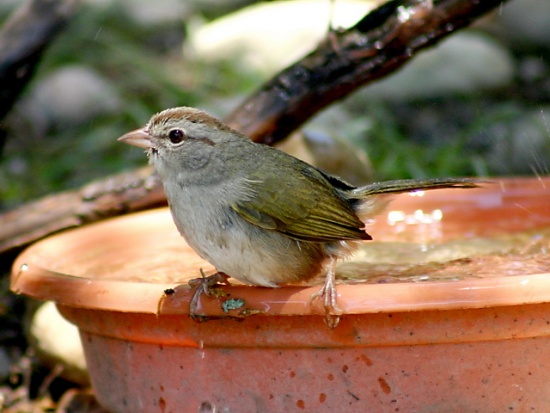- Arremonops rufivirgatus
Identification
Length 16cm (6.25in), wingspan 23cm (9in)
Two prominent brown longitudinal stripes on head, brown eye stripes, upper body dull olive green, buff underparts, legs pinkish-brown. (This is the only sparrow with an olive back.)
Males and females are the same.
Juveniles are more buff with faint streaking on breast and neck.
Similar Species
Similar in coloration to the Green-tailed Towhee, but smaller, and lacks the rufous cap.
Distribution
Southern Texas to Guatemala; northwest Costa Rica.
Fairly common along the Mexico coasts, range extends barely into Texas along the lower Rio Grande Valley, but is found regularly on the west side of the Texas Hill Country.
Taxonomy
Subspecies
This is a polytypic species, consisting of nine subspecies[1]:
rufivirgatus Group
- A. r. rufivirgatus: Southern Texas to north-eastern Mexico (Coahuila and Nuevo León to Tamaulipas)
- A. r. ridgwayi: Eastern Mexico (southern Tamaulipas to San Luis Potosí and northern Veracruz)
- A. r. crassirostris: Coastal south-eastern Mexico (Veracruz to eastern Puebla and northern Oaxaca)
- A. r. verticalis: South-eastern Mexico (Yucatán Peninsula) to Petén of northern Guatemala and northern Belize
- A. r. rhyptothorax: South-eastern Mexico (Yucatán Peninsula)
superciliosus Group (Pacific)
- A. r. sinaloae: Coastal western Mexico (Sinaloa to Nayarit)
- A. r. sumichrasti: Coastal south-western Mexico (Jalisco to Colima, Michoacán and Oaxaca)
- A. r. chiapensis: Southern Mexico (central valley of Chiapas)
- A. r. superciliosus: Pacific coast of north-western Costa Rica
Habitat
Riparian thickets, thorny scrub and second growth.
Behaviour
Individuals or pairs forage on the ground and low in trees and bushes. Scratches in leaf litter in a similar manner to towhees.
Voice varies geographically. The song of the subspecies in Yucatan and further south often accelerates towards the end of the phrase.
References
- Clements, J. F., T. S. Schulenberg, M. J. Iliff, S. M. Billerman, T. A. Fredericks, B. L. Sullivan, and C. L. Wood. 2019. The eBird/Clements Checklist of Birds of the World: v2019. Downloaded from http://www.birds.cornell.edu/clementschecklist/download/
- BF Member observations
Recommended Citation
- BirdForum Opus contributors. (2025) Olive Sparrow. In: BirdForum, the forum for wild birds and birding. Retrieved 12 March 2025 from https://www.birdforum.net/opus/Olive_Sparrow
External Links
GSearch checked for 2020 platform.1





